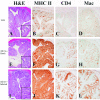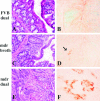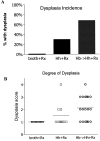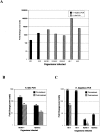Dual infection with Helicobacter bilis and Helicobacter hepaticus in p-glycoprotein-deficient mdr1a-/- mice results in colitis that progresses to dysplasia
- PMID: 15920164
- PMCID: PMC1602406
- DOI: 10.1016/S0002-9440(10)62489-3
Dual infection with Helicobacter bilis and Helicobacter hepaticus in p-glycoprotein-deficient mdr1a-/- mice results in colitis that progresses to dysplasia
Abstract
Patients with inflammatory bowel disease (IBD) are at increased risk for developing high-grade dysplasia and colorectal cancer. Animal IBD models that develop dysplasia and neoplasia may help elucidate the link between inflammation and colorectal cancer. Mdr1a-/- mice lack the membrane efflux pump p-glycoprotein and spontaneously develop IBD that can be modulated by infection with Helicobacter sp: H. bilis accelerates development of colitis while H. hepaticus delays disease. In this study, we determined if H. hepaticus infection could prevent H. bilis-induced colitis. Unexpectedly, a proportion of dual-infected mdr1a-/- mice showed IBD with foci of low- to high-grade dysplasia. A group of dual-infected mdr1a-/- animals were maintained long term (39 weeks) by intermittent feeding of medicated wafers to model chronic and relapsing disease. These mice showed a higher frequency of high-grade crypt dysplasia, including invasive adenocarcinoma, possibly because H. hepaticus, in delaying the development of colitis, allows time for transformation of epithelial cells. Colonic epithelial preparations from co-infected mice showed increased expression of c-myc (5- to 12-fold) and interleukin-1alpha/beta (600-fold) by real-time polymerase chain reaction relative to uninfected wild-type and mdr1a-/- animals. This animal model may have particular relevance to human IBD and colorectal cancer because certain human MDR1 polymorphisms have been linked to ulcerative colitis and increased risk for colorectal cancer.
Figures










Similar articles
-
Helicobacter bilis infection accelerates and H. hepaticus infection delays the development of colitis in multiple drug resistance-deficient (mdr1a-/-) mice.Am J Pathol. 2002 Feb;160(2):739-51. doi: 10.1016/S0002-9440(10)64894-8. Am J Pathol. 2002. PMID: 11839595 Free PMC article.
-
Colitis-induced bone loss is gender dependent and associated with increased inflammation.Inflamm Bowel Dis. 2013 Jul;19(8):1586-97. doi: 10.1097/MIB.0b013e318289e17b. Inflamm Bowel Dis. 2013. PMID: 23702805 Free PMC article.
-
Differential susceptibility of P-glycoprotein deficient mice to colitis induction by environmental insults.Inflamm Bowel Dis. 2009 May;15(5):684-96. doi: 10.1002/ibd.20824. Inflamm Bowel Dis. 2009. PMID: 19067430 Free PMC article.
-
The mdr1a-/- mouse model of spontaneous colitis: a relevant and appropriate animal model to study inflammatory bowel disease.Immunol Res. 2005;31(2):151-9. doi: 10.1385/IR:31:2:151. Immunol Res. 2005. PMID: 15778512 Review.
-
Helicobacter hepaticus infection in mice: models for understanding lower bowel inflammation and cancer.Mucosal Immunol. 2011 Jan;4(1):22-30. doi: 10.1038/mi.2010.61. Epub 2010 Oct 13. Mucosal Immunol. 2011. PMID: 20944559 Free PMC article. Review.
Cited by
-
Differential effects of energy balance on experimentally-induced colitis.World J Gastroenterol. 2012 Feb 21;18(7):627-36. doi: 10.3748/wjg.v18.i7.627. World J Gastroenterol. 2012. PMID: 22363133 Free PMC article.
-
Helicobacter infection decreases reproductive performance of IL10-deficient mice.Comp Med. 2008 Oct;58(5):447-53. Comp Med. 2008. PMID: 19004370 Free PMC article.
-
Novel understanding of ABC transporters ABCB1/MDR/P-glycoprotein, ABCC2/MRP2, and ABCG2/BCRP in colorectal pathophysiology.World J Gastroenterol. 2015 Nov 7;21(41):11862-76. doi: 10.3748/wjg.v21.i41.11862. World J Gastroenterol. 2015. PMID: 26557010 Free PMC article.
-
Kinetics of severe dengue virus infection and development of gut pathology in mice.J Virol. 2023 Nov 30;97(11):e0125123. doi: 10.1128/jvi.01251-23. Epub 2023 Oct 18. J Virol. 2023. PMID: 37850747 Free PMC article.
-
CD4+ lymphocytes modulate prostate cancer progression in mice.Int J Cancer. 2009 Aug 15;125(4):868-78. doi: 10.1002/ijc.24452. Int J Cancer. 2009. PMID: 19408303 Free PMC article.
References
-
- Dancourt V, Faivre J. Epidemiology and screening of colorectal cancer. Rev Prat. 2004;54:135–142. - PubMed
-
- Kobaek-Larsen M, Thorup I, Diederichsen A, Fenger C, Hoitinga MR. Review of colorectal cancer and its metastases in rodent models: comparative aspects with those in humans. Comp Med. 2000;50:16–26. - PubMed
-
- Galvez JJ, Cardiff RD, Munn RJ, Borowsky AD, Boivin GP, Groden J, Longnecker DS, Shmidt EN, Nikitin AY, Connolly DC, Hamilton TC. Mouse models of human cancers (part 2). Comp Med. 2004;54:13–28. - PubMed
-
- Karlen P, Lofberg R, Brostrom O, Leijonmarck CE, Hellers G, Persson PG. Increased risk of cancer in ulcerative colitis: a population-based cohort study. Am J Gastroenterol. 1999;94:1047–1052. - PubMed
-
- Bachwich DR, Lichtenstein GR, Traber PG. Cancer in inflammatory bowel disease. Med Clin North Am. 1994;78:1399–1412. - PubMed
Publication types
MeSH terms
Substances
Grants and funding
LinkOut - more resources
Full Text Sources
Medical
Molecular Biology Databases

